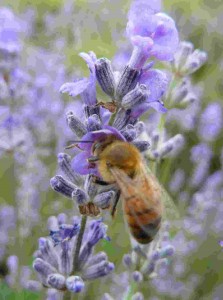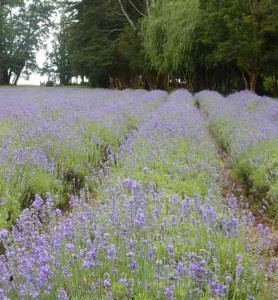Of over 39 species of Lavender, the most popular species for commercial crops are True Lavender, Spike Lavender and Lavandin, a hybrid of these two. These are the sources of most Lavender honeys. The characteristics of the honey vary depending on the relative concentrations of each of the species, mainly evidenced by differences in aroma and camphor notes.
Lavender honey is a premium honey. Flowery, pleasant, well balanced and rounded, very fine honey aroma and the delicate floral scent with an evident Lavender component. It has a very persistent medium sweet taste that grows with the finish. In some cases it has slightly sour notes. Light white to extra light amber. If it is dark in the presence of honeydew, it may have some salty notes. An extraordinary honey. It contains weak acidity without bitterness, lingers in the mouth. Moderate crystallization, very fine.
Another species of Lavender, Spanish Lavender, is often cultivated apart and is described below.
To be classified as a single flower (monofloral) Lavender honey in the EU only 15-20% pollen count is required (mainly due to the low pollen count of the Lavandin varietal).
Lavender honey is delicious over feta cheese, and pairs well with blue cheeses and semi-soft cheeses such as the decadent triple-crème-styles like Pierre Robert or Brillat-Savarin.
Lavender came originally from Persia and the Spanish Canary islands. Today, lavender is grown in many countries including Tasmania, Spain, India, Arabia, Italy, England, China, Yugoslavia, Bulgaria, North America, Australia and southern France, where centuries of cultivation have produced some of the most highly developed forms of the plant.
The Greeks and the Romans used it to scent their baths or their freshly laundered linen. The word “lavender” actually comes from the Latin verb “lavare”, which means “to wash”. They also used this precious aromatic plant for its soothing and healing qualities. During the plague of 1720 in Europe, people tied lavender to themselves to protect themselves from the disease. Botanists and pharmacists were quick to research its medicinal properties. For instance, it is beneficial in healing burns. In 1770, the Parliament of Provence, France, aware of its beneficial attributes, regulated the cutting of lavender and its extraction into an essential oil.
True lavender or Common or English Lavender (Lavandula angustifolia), the most common true or non-hybrid, has a green, hay-like sweetness and gives “fruity aspects” to perfumes and other scented products. It has the lowest camphor content of all species. It has strong anti-inflammatory properties and is alleviates tension-related illnesses. It is the source of essential oils providing a variety of aromatherapy properties. Source of France and Spain Lavender honeys.
Spike Lavender (Lavandula latifolia) this lavender has broad leaves and branched flower stalks, otherwise similar to English Lavender. This is the classic lavender used in sachets, perfumes, wands, etc. It has a higher camphor content than True. The aroma is camphoraceous, floral, fresh and herbaceous. Foliage is aromatic and grey-green and flowers are mauvish-blue, appearing in July and August. Source of Spain and France Lavender honeys.
Lavandin (Lavandula x intermedia), a natural hybrid of True and Spike Lavender, accounts for the majority of cultivated lavender for essential oil, with beautiful, vibrant colors, often used for herbal crafts and potpourris. The scent of its oil is woody, spicy-green, camphor–is quite different from true lavender and while it has many fine properties, it is not a substitute for true lavender or its aromatherapy properties, and because of its high camphor content is not suitable for burn treatment. Source of France Lavender honeys.
Spanish Lavender (Lavandula stoechas) is often cultivated apart from the species above. Its honey is a white to extra light amber. Faint floral aroma, less intense, a little persistent, sometimes with very slight camphor notes. Sweet taste, in some cases slightly sour notes. Slow, fine crystallization. The taste and aroma shows a hint of almond, Sometimes with a smell of stale tobacco. Its smell is kind of vegetable, rather discreet. It grows wild in the Mediterranean region and is considered an invasive species in Australia. The flower differs from the other Lavenders as it is barrel shaped. Used in traditional medicine as an anticonvulsant and antispasmodic. Source of Portugal, Italy (Sardinia) and Spain Lavender honeys.
Lavender Festivals: A great excuse to get out and enjoy the countryside and the beauty of Lavender. Take a moment to watch the busy bees! Enjoy the festive atmosphere and numerous products and crafts inspired by lavender, starting with lavender honey, bouquets and essential oils, nougat, ceramics, basketry, textiles, colored lavender figurines, soaps and scented candles, lavender landscapes painted or photographed, sherbet, syrup and lavender lemonade. There are dozens of lavender festivals around the world, here a few:
- “Corso de la Lavande” in Digne, France, a five day celebration starting at the first weekend of August.
- The “Fete de la Lavende” in Montélimar, France is one of the largest festivals, in early July.
- “Sequim Lavender Festival” in Sequim, Washington, U.S., one of the largest festivals in the U.S., in mid July.
- “Pennsylvania Lavender Festival”, Willow Pond Farm, Fairfield, PA, in mid June
- “Oregon Lavender Festival”, Yamhill and surrounding farms, Oregon, U.S., in early July
Latin Name: True Lavender, Espliego (Lavandula angustifolia, officinalis, vera); Spike Lavender, Aspic (Lavandula spica, latifolia); Lavandin (Lavandula x intermedia); Spanish Lavender, Cantueso (Lavandula stoechas)
Honey Origin: Produced mainly in France, Spain and Italy, however it is also available from other Lavender producing countries such as Bulgaria, England, USSR, Yugoslavia, Australia, USA, Canada, South Africa, and Tanzania. It flowers from mid spring to late summer.
Translations: French: Lavande vraie; Italian: Lavanda vera; Spanish: Lavanda
Protected Geographical Status (PGS) framework (PDO/PGI) – EU: Miel de Granada (Spain), Miel de la Alcarria (Spain), Miel de Lavande Label Rouge (Provence, France), Miel de Provence (France)
————————————————————————————————–
References:
1/ Floral quality and discrimination of Lavandula stoechas, Lavandula angustifolia, and Lavandula angustifolia×latifolia honeys doi:10.1016/j.physletb.2003.10.071
2/ Official website of the Essential Oil of Lavender Haute Provence AOC – APAL 2008 (www.lavande-provence-aoc.com)






Where can I buy bulk seed for True Lavender and Spike Lavender? I’ve been looking but no one seems to sell the seeds. Any help would be appreciated.
thank you.
Thank you for all information , but where can i buy lavender hony . Could you help to find it .
Thank’s
Hi Mamdouh:
Sure. Try this: https://www.miel-du-sud.fr/pages/produits.php?id=1&cat=miel#pro1 I bought honey from them about 4 months ago. It was excellent!
It is French. I used Google translate to help, but you don’t really need to. I gave the link to the page. Miel de Lavande
Let me know how you liked it!
….Scott
To the person looking for Lavender seeds, Good luck. Most are hybrids and their seeds wont do much. You will need to get plants or rooting stock. You can propagate the plants by laying the branches on the ground and covering them with dirt so they will root and form another plant.
As for the Lavender honey,you might try https://loesshillslavender.com/Home/ They have a very small amount this year.
Tom
Spanish lavender honey is good, I buy it from the local market Lavender is Espliego in Spanish.
I think it is also available from the website
https://www.lamieleria.com/en/
Hello. I hope you can help me. I am looking for beekeepers in Portugal who can supply me with chestnut and lavender honey in buckets of 5 kg. This is to be a regular order and to be sent by regular mail to Israel. Thank you.